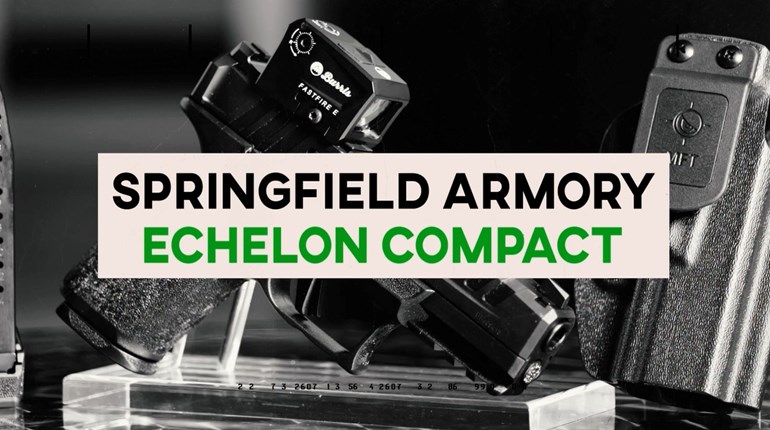
Shown above: The CMMG MkG Guard pistol-caliber carbine is shown with several of its distinctive, stand-out features. Notably, the gun is chambered in .45 ACP, thanks to a novel radial-delayed blowback system, and feeds from commonly available Glock pistol magazines.
Different groups of enthusiasts have different mythical creatures. Outdoorsy types have Bigfoot, the Loch Ness Monster and the Abominable Snowman. Fans of fantasy have goblins, elves, dwarves and many others. Gunnies are no different, except our mythical creatures tend to be more like “an affordable Colt Python” or “a Bren Ten with more than one magazine.” And then there’s one of the most-rare creatures out there: An AR-15 in .45 ACP that takes modern magazines and runs reliably.
At the 2017 SHOT Show, the guys at CMMG were visibly excited when we visited the company’s booth. “You have got to see this,” we were told, as we entered the conference room area inside the booth. With great fanfare, the CMMG MkG Guard was unveiled to us in a sneak peak (it would be officially released at NRA Annual Meeting in Atlanta, GA, several months later). Of course, it was exciting, but we had seen .45 ACP-chambered AR-15-pattern rifles before. The big question, of course, remained to be seen: Would the CMMG Guard work?
Now, before we get to the answer, there are a few things about the CMMG MkG Guard to discuss. First off is this “radial-delayed blowback” operating system. Now, when you hear the word “radial,” two things might come to mind—tires and airplane engines—and neither of those has to do with pistol-caliber-carbine (PCC) operating systems. CMMG uses this description to refer to the slowing of the bolt in the bolt-carrier group through rotation, but we’ll let CMMG Product Development Manager Tyson Bradshaw explain the technical aspects.

“The radial-delayed blowback system on the CMMG MkG Guard was designed to overcome unreliable feeding that can be experienced with a straight-blowback .45 ACP design. While the concept of a delayed-blowback system is not new, it had not yet been done on an AR-15. It took a lot of time and creativity to make this system compatible with the AR platform while still using mostly standard AR parts.”
He explained further, “The bolt-carrier group (BCG) looks very similar to a standard direct-impingement BCG with a few subtle differences that make it operate differently. The two features that drive this system are chamfering the back of the locking lugs and a modified path for the cam-pin slot in the carrier. This ensures that the bolt will rotate into battery, but allows a tiny bit of the bolt to not overlap with the barrel extension. When the cartridge goes off [detonates], the chamfer on the back of the locking lugs is forced into the barrel extension. This chamfer is what causes the bolt to rotate, forcing the carrier rearward until the bolt is fully ‘unlocked.’ Once it is ‘unlocked,’ the action cycles like a standard straight blowback system. This ‘unlocking’ sequence takes long enough to allow the chamber pressure to drop to a safe level while still having enough momentum to cycle the entire action.”

Basically, the big advantage of this operating system compared to a straight blowback system is decreased felt recoil. Additionally, it allows the CMMG MkG Guard system to remain lighter than traditional means. Bradshaw explained that, “Most of this weight saving is in the reciprocating mass (bolt and buffer). The other big advantage of this system is it opens up the possibility to run calibers that have historically been too powerful for straight blowback but weren’t suited for direct impingement.”
Another matter for discussion involved the unconventional look of the magazine. Since the CMMG MkG Guard uses standard Glock magazines, the magazine well needs to be canted slightly rearward to present the proper feeding geometry. (Look at the grip of a Glock handgun, and you’ll see the same angle, it’s just obscured by your hand.) CMMG felt it more important to use a modern, readily available magazine such as the G21 13-round variant rather than something like an M3 Grease gun magazine, which would feed at a 90-degree angle. In this case, aesthetics took a back seat to function, which is fine with us. The company felt it so important that it now offers the Guard in 9 mm—feeding from 33-round Glock magazines—even though CMMG’s Mk9 (which feeds from Colt-pattern magazines) has been in the lineup for some time.

Bradshaw confirmed the choice of Glock-based magazines by saying, “From the outset, one of our design goals for the CMMG MkG Guard was to make it feed from factory Glock magazines. Compared to other options on the market, we felt like the Glock magazines presented some obvious advantages in terms of availability, creating magazine commonality between the Guard and one’s defensive pistol and also optimizing it for use in PCC competition.”
It’s one of those things. Had CMMG decided to offer the Guard compatible with M3 magazines, many would have argued in favor of Glock or other more modern variants. Instead, the complaints run more to the capacity of the existing magazines. (It’s almost like the gun community is fickle and wants something about which to complain.) But, I digress. Aftermarket options do exist, from floorplate extensions that add two to five rounds, to increased-capacity magazines holding in excess of two dozen rounds. CMMG does recommend factory Glock G21 13-round magazines for best operation, however, and we were not able to obtain any aftermarket variants for testing.
Other than the interesting operating system and somewhat unconventional look of the magazine, the Guard is standard AR-15 everywhere else. Buttstock and pistol grip are standard AR-15 furniture, so there’s an entire universe of aftermarket accessories available. Lower components are interchangeable (obviously because of the magazine well, the lower is not), so upgrading the trigger or adding an ambi safety can be performed rather easily. Prefer M-Lok to KeyMod on the handguard? No worries—CMMG offers both attachment systems, and the CMMG MkG Guard can be upgraded to M-Lok. Now, the molded trigger guard obviously can’t be changed, and the magazine release is proprietary to the pistol magazines, so that has to stay as is, but there is still plenty of customization possible.

Now, where were we? Ah, yes, the function. But, before we delve into the performance, there’s a philosophical component we should discuss. Namely, why on earth would anyone want an AR-15 carbine in .45 ACP, like the CMMG MkG Guard? There are some pretty compelling arguments for a 9 mm AR: Ringing steel plates at closer range, less ammo expense in a non-rimfire variant, some ranges are limited to pistol-calibers only, etc. But .45 ACP? Usually that caliber is touted as a more-potent alternative to 9 mm—and should you want a more-potent AR-15, there are a number of extant calibers to suit your needs.
Let’s get one thing straight, right away. “Because it’s cool” is an absolutely valid reason. “Because I want one,” ditto. Heck, “Because [physical impossibility] you!” fits here. All of these are splendid reasons for a .45 ACP AR-15. If you’re looking for a more, well, mathematical line of thinking why you’d want one, we’ve got two words: muzzle energy (ME). A 55-grain .223 Rem. has approximately 1,000 ft.-lbs. at the muzzle, while hot .45 ACP can approach the 700 ft.-lbs. range, out of a 16-inch barrel. Not to start the holy war of “9 mm vs. .45 ACP” all over again, but hottest 9 mm runs about 500 ft.-lbs. Going from a mid-range rifle round like the 5.56 NATO to a pistol-based .45 ACP in a home-defense carbine doesn’t lose a whole lot of energy.
Because we’re firm believers in doing the math, allow us to show our work: A 55-grain 5.56 NATO round traveling at 2,900 fps out of a 16-inch barrel yields 1,027 ft.-lbs. ME. A 185-grain .45 ACP round reaching 1,200 fps will give 591 ft.-lbs, while a 115-grain 9 mm at 1,185 fps produces 359 ft.-lbs. ME out of the same 16-inch barrel. While the 5.56 NATO is the clear winner, bear in mind that round will also produce approximately 159 dB, while 9 mm hits 160 dB and .45 ACP the lowest at 151 dB.
Suppressors obviously will make a difference, but if your home-defense carbine isn’t a short-barrel-rifle, adding one will significantly alter its maneuverability, while drastically reducing the suppressor’s ability to do its job. Turning your carbine into an SBR mitigates the suppressor length, but adds two tax stamps. Running .45 ACP in a CMMG MkG Guard gives a healthy balance of muzzle energy, recoil control and less-damaging sound levels from an out-of-the-box option.
Running the CMMG MkG Guard as a home-defense option makes a lot of sense, especially if you’re already versed in the care, feeding and operation of the AR-15. It’s maneuverable, you can easily attach a light and it can be suppressed—should you be concerned about hearing safety. Recoil is (to use a hoary cliché) quite manageable, and with a quality red-dot optic on top, the Guard can be run quickly with great accuracy, especially at the distances typically at play in a home-defense situation. Add in the ease with which you can attach accessories like lasers, slings, etc. to the AR-15-style platform, and the Guard starts to look mighty attractive as a home-defense option. For those who have taken carbine-based training, such as Gunsite’s 223 Carbine Class, all drills and skills should transfer seamlessly to the Guard from any modern M4-based experience.
All this is for naught, though, if the gun doesn’t run. Shortly before the NRA Annual Meeting in Atlanta, GA, last year, the folks at CMMG came out to NRA headquarters for a visit. Naturally, they brought the new Guard with them, and we had a chance to try it out on the range. Both the pistol variant and carbine were procured, and within a few minutes of finding the point-of-impact we were ringing steel at 100 yards. All who handled the CMMG MkG Guard remarked on how little recoil was felt, and no malfunctions were observed in our limited time in the field.
Naturally, we wanted to give the Guard a good, thorough going-over to see if we could break it. Obviously, the first test centered on 230-grain FMJ, because if it won’t feed ball, there’s just no point in continuing. We tried ultra-light projectiles like Inceptor’s 114–grain ARX—with a blistering velocity of 1,434 fps—if that didn’t befuddle the radial-delayed blowback, we figured, nothing would. Two defensive options, jacketed hollowpoints of 165- and 200-grain weight, were included in testing to ensure proper operation in the CMMG MkG Guard.
We did discover one interesting tidbit on the range. The Guard didn’t care for the bullet profile of the Federal 165-grain Hydra-Shok. Several failures-to-feed were experienced, and highlight the importance of testing any firearm you might use defensively with a range of ammunition to ensure proper function. The remainder of testing saw no malfunctions through a wide variety of bullet weights and profiles. We ran in excess of 500 rounds through the CMMG MkG Guard, with only the one noted exception to superlative function.
Truly unique and a solid home-defense carbine, the CMMG MkG Guard brings the familiarity of AR-15-style controls with the American-as-apple-pie .45 ACP chambering. In the world of pistol-caliber carbines, where 9 mm variants are a dime-a-dozen, the Guard stands out in a much less-crowded field. Whether you’re looking for a companion carbine for your G30, something different to take to the range or a dedicated home-defense carbine, the CMMG MkG Guard makes a solid, unique choice.





































